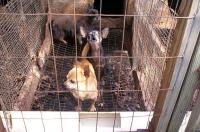The Truth About Puppy Mills
Where do those cute puppies you see in the pet stores come from? Most of them come from large dog breeding operations known as Puppy Mills. You've probably heard of these places and heard about the many rescue movements in place to put an end to them, and for good reason!
Puppies born in puppy mills and their parents are raised in cages like livestock and mass-produced for shipment all over the country. They arrive in your local petshop tired, stressed, and often sick with parasites and viruses. Any veterinarian can tell you horror stories about hookworms, roundworms, pneumonia and parvovirus. Sometimes the puppies look healthy when you buy them, but then become deathly ill about a week after you get them home. This is because they were already exposed to a virus, but it had not had time to take effect in the pet's body. This is called the incubation period.
The saddest part is that now the pet store wants you to return "the merchandise" for a refund or exchange it for a new model. The problem is, most families have already bonded to their new puppy, so they spend hundreds of dollars to make it well, or they have to explain to small children why it died. Every pet store puppy will not get sick, but do you really want to take that chance? Do you want to support Puppy Mills? As long as we keep buying these puppies, the "factory" will keep producing them. If you purchase a purebred pet from a "backyard" breeder, not a pet store, your puppy or kitten may be healthier, but not always, and again, you're encouraging "production" of puppies.

Homeless Pets Need Adoption
According to the A.S.P.C.A., 2.7 million homeless pets are euthanized in shelters every year in this country. 2.7 million dogs and cats. This is the fault of people who allow their pets to breed indiscriminately, who fail to spay and neuter, who don't recognize the responsibility of pet ownership, and who buy mass produced puppies from pet stores, thereby supporting the inhumane business of puppy mills. These same irresponsible people also move and leave their pets on the street or at a shelter.
Home-grown breeding, backyard breeding, or stray dogs reproducing leads to offspring that are sickly, unwanted, or can't find homes, and they end up on the street or in shelters themselves. Some pets end up in a shelter because their owners loved them dearly but could not keep them for financial or health reasons. These pets are most often perfectly healthy and emotional sound, except for missing their families. All of these dogs and cats deserve a second chance.
Most shelters use whatever means they can to spay, neuter, vaccinate and treat medical problems for pets in their care. Veterinarians and their staff donate millions of work hours and dollars to help prepare homeless pets for adoption.
We recommend taking every new pet to a veterinarian for a thorough examination within the first week, to make sure the pet is healthy and is on a plan for additional care if needed. If you MUST purchase from a breeder, make sure the breeder requires your pet to be spayed or neutered, and will take the pet back from you if things don't work out. Some breeders are doing their part to keep pets they sell from adding to the homeless population.
It is your decision. You can buy a dog or cat from someone whose only goal is profit, or you can support millions of people who are working every day to reduce the population of the world's homeless animals. Most of our WhiskerDocs members and all of our employees have rescued pets. We are asking you to join us in saving lives. Consider adoption first!
